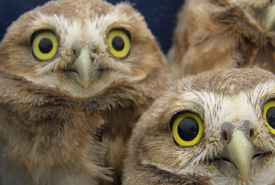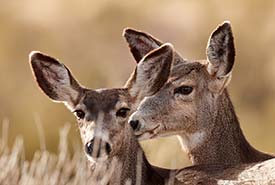Jackson Pipestone Prairie and Wetlands

Juvenile burrowing owls (Photo by Lauren Meads)
You can be a part of securing burrowing owl habitat in southern Manitoba
They’re as tall as pop cans, as voracious as T-Rexes and among one of Manitoba’s most rarely seen endangered species. But now burrowing owls have more conserved habitat to call home in southern Manitoba.
The Nature Conservancy of Canada (NCC) is protecting over 500 hectares of native prairie and wetland habitat across two conservation areas near the communities of Broomhill and Pipestone. Significant and rapid habitat loss means these lands now stand among the last bastions of native mixed-grass prairie in the province, an ecosystem which is critical for many at-risk species, including burrowing owl.
The Jackson Pipestone Prairie and Wetlands project features native prairie and wetlands, with Jackson Creek and its floodplain area making up the remainder. The songs of at-risk grassland birds like chestnut-collared longspur, bobolink and Baird’s sparrow form a chorus in the air, signalling its importance for biodiversity in the region.
Located within two internationally recognized Important Bird Areas, portions of the project are made up of sustainably pastured lands that support birds such as the burrowing owl, and wetlands that are alive with birds like red-necked phalarope, lesser yellowlegs, black-crowned night herons, and tundra swan.
The former owners of these lands are largely to thank for the vibrant diversity of birdsong and prairie species observed on them today. The Gervin family has been involved in burrowing owl recovery since the 1980s. They worked with the Manitoba Burrowing Owl Recovery Program since it’s inception in 2010 to protect habitat for the endangered birds across their properties and support their reintroduction. In 2019, the family was awarded the Prairie Conservation Award for Manitoba, in recognition of their dedication to the stewardship of the lands. Now under the stewardship of NCC, the family’s love for the land can continue in perpetuity.
By working together to support sustainable management practices, such as the grazing that is taking place on the Jackson Pipestone Prairies and Wetlands, NCC can help protect biodiversity. NCC works with livestock producers whose cattle graze the Prairie grasslands and help Prairies to thrive, while supporting a strong livestock industry.
“In Manitoba, it is estimated that 90 per cent of native prairie grasslands have already been lost, creating a real and urgent concern for the species, communities, farmers, producers and Indigenous Peoples who rely on them. We want to thank everyone who made these two important conservation projects possible. By working together, we can protect Manitoba’s natural gems and sustain healthy communities for wildlife, plants and people.” — Josh Dillabough, Natural Area Manager, NCC in Manitoba
“Burrowing owls are conservation-dependent. The Manitoba Burrowing Owl Recovery Program (MBORP) has worked with the Gervin family and NCC since 2010 reintroducing burrowing owls on this land. Most recently, we have observed wild owls back in this area that are using artificial nest burrows that our program has installed for extra protection for nesting burrowing owls. Without people and organizations like the Gervin's and NCC working to protect spaces like the Jackson Pipestone Prairie for species like the burrowing owl, the burrowing owl will disappear from Manitoba” — Alexandra Froese, Founder & Executive Director, Manitoba Burrowing Owl Recovery Program
Prairie Grasslands Action Plan
This project is a part of NCC’s Prairie Grasslands Action Plan — aimed to conserve more than 500,000 hectares by 2030 — an area six times the size of Calgary, equivalent to what will be lost if we don’t act now to protect the grasslands that remain.
Although NCC has already raised nearly 90 per cent of what’s needed to secure and steward these ecologically important lands in southern Manitoba forever, we need your help crossing the finish line.
Learn more about how you can take action to care for Canada’s iconic Prairie grasslands, such as the Jackson Pipestone Prairie and Wetlands, at prairiegrasslands.ca
Quick facts

Cerfs mulets (Photo de Henry/Flickr-cc)
Location: Mixed-grass Prairie and the Oak Lake Sandhills and Wetlands natural areas
Size: 518 hectares
Habitat: Native mixed grass prairie, Stoney Creek riparian area, wetlands
Closest communities: Broomhill & Pipestone, MB
Species: Sprague’s pipit, great plains toad, Baird’s sparrow, savannah sparrow, ferruginous hawk, chestnut-collared longspur, prairie loggerhead shrike, burrowing owl, bobolink, barn swallow
When nature thrives, we thrive
Not only do these natural areas provide ecological benefits, but they also provide an essential tool for health promotion and well-being.
Evidence shows that spending time in nature grows environmental stewards. Adults who care for nature most often attribute this to time spent in nature as a child.
In a time when habitat loss, climate change and species extinction threaten our landscapes, connecting to nature is now, more than ever, important.
By protecting nature, you’re also protecting the benefits that it provides to people.
Please join us and support the Nature Conservancy of Canada’s grassland conservation initiative to conserve projects like Jackson Pipestone Prairie and Wetlands. This is your chance to be a part of the conservation of this important place, a place that provides a connection to the land for today, and for tomorrow.
Donations may be pledged over time and made by cash, credit card, cheque, or securities transfer. All or a portion of your gift may be committed to our stewardship endowment fund, which helps to ensure the long-term care and management of NCC’s properties. Up to 20% of your gift may support activities that advance NCC’s mission.





